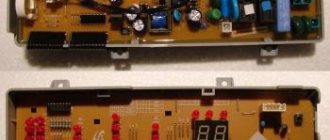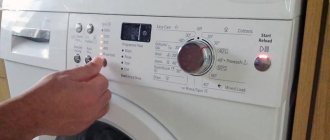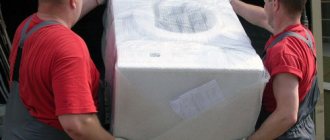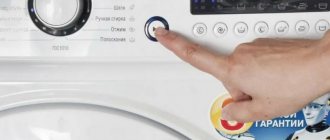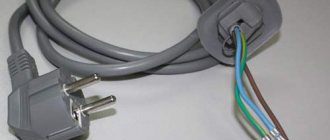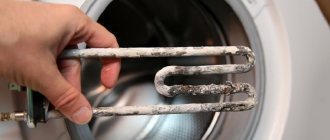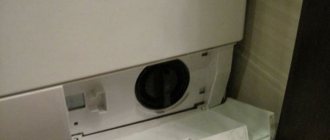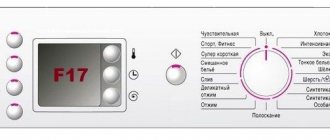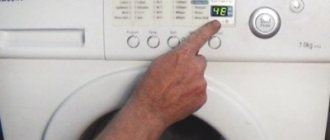Automatic washing machines, like other household appliances, have their own service life. Moreover, it depends both on the quality of assembly at the factory and on proper use.
Often a nuisance arises when water starts flowing from below during the washing process. This indicates a malfunction and must be promptly intervened to correct. By the way, breakdowns occur quite often and sometimes you can fix them yourself. But you need to understand the causes.
- What to do if there is a leak?
- Main types of breakdowns
- Is it worth repairing it yourself?
- Conclusion
- Catalog of washing machines with reviews
What to do if there is a leak?
If a puddle has already appeared at the time of washing, you must immediately disconnect the machine from the power supply. It is advisable to do this without entering the room, if possible. It is worth considering that if the machine is running and surrounded by water, this can cause death. Therefore, caution must be exercised.
Washing machine leaks from below during washing
Once the power is turned off, you can move on to the next steps. First you need to turn off the water supply to the device. Next, using the filter, which is located in the lower right corner of the front, you will need to drain the water. All that remains is to open the hatch and remove the laundry, remove the water from the floor and proceed to the inspection.
Causes of leakage
The modern household appliances market is rich in a variety of models of automatic washing machines. Even models from well-known manufacturers (Samsung, Indesit, LG, etc.) may have their own shortcomings and weak points that can leak during long-term operation of the equipment. A washing machine can leak for various reasons:
- Violation of the rules for operating a washing machine;
- Using the wrong brand of washing powder;
- Mechanical damage to the machine;
- Use of low-quality parts during repair and assembly of the unit;
- Manufacturing defects.
Inspection of the breakdown
If you find a stain on the floor near a running washing machine, try to avoid contact with water. Contact with operating equipment that is leaking water can result in electric shock, even death. Therefore, it is necessary, first of all, to turn off the power to the washing machine by disconnecting it from the power supply. If you cannot remove the plug from the socket, you must run to turn off the electricity in the entire room.
Then you must limit the flow of water into the machine. To do this, you need to turn off the water supply tap to the device or completely cut off the water supply to the system.
After these operations, you need to use a drain filter to remove the remaining water in the washing unit.
Then only you can begin an external inspection of this household device.
Damage to washing machine components leading to leakage
- Tank leakage;
- Leaking drain pump (pump);
- Violation of the tightness and integrity of the hoses;
- Damage to the door seal;
- Lack of tightness of the filler pipe connection;
- Wear of the tank seal;
- Presence of debris in the powder dispenser hopper;
- Damage to the tank drain pipe.
Online diagnostics of a washing machine
If your machine stops washing or rinsing clothes normally, then some kind of malfunction or breakdown has occurred.
You can try to find the problem yourself. Run diagnostics
Select which operation your washing machine does not perform:
1. Doesn’t drain 2. Doesn’t rotate the drum 3. Doesn’t spin clothes 4. Noises, knocks, buzzes when spinning 5. Doesn’t turn on
Checking the operation of the drain pump Is the drain pump of the washing machine working? Yes No I don’t know << Back
Clogged hoses in the washing machine If the sound corresponds to the normal sound that has always been observed when the device is working, the cause is probably a clog.
Was there a blockage in the drain hose? Yes
<< Back
The drain pump does not work! If the sound matches the normal sound of the drain pump, it is recommended that you check the drain filter first.
After cleaning, does the drain pump work and does the washing machine drain water? Not really
<< Back
Operation of the drain pump The sound of the pump is usually immediately audible and noticeable. If there is no sound, the pump is not working. We are looking for how to separately enable the water drainage program. As a rule, this is a separate option. After the program has been turned on, the pump should start working in 1-3 seconds. If everything is done correctly and the pump is operational, a buzzing sound will appear. If you hear no buzzing or other sounds when you turn on the program, the pump is probably faulty.
Is the washing machine drain pump working? Not really
<< Back
Clogged car hoses If you have identified a clog in the hoses, you need to disassemble them, clean them, and then reassemble everything.
Does the washing machine drain well? Not really
<< Back
Hurray, you did a great job, you fixed it.
<< Return to the beginning of diagnostics
The drain pump is faulty, call a professional.
<< Return to the beginning of the diagnosis.
The washing machine does not rotate the drum. During the operation of the washing machine, such a problem may occur. Each model has a different drum operation. It rotates according to a given algorithm, which is set by the program. This principle applies to spinning and washing. If you are not sure whether the drum is not spinning or whether it is working, put the laundry in the washing machine. Start the spin program. If the machine is running, it will first drain the water and then start spinning. In this case, a rotational process will be observed. If rotation is not visible, then check the belt. First, turn off the program, then unplug the wire from the outlet so that power does not flow into the device. Now you need to remove the back cover. You will need to carefully inspect the drum belt. It is quite easy to determine whether it is in the wrong position or damaged.
Is the washing machine belt torn or stretched? Not really
<< Back
Broken drum drive belt If the belt breaks, it will be immediately visible. There are also often cases when the belt simply stretches, which is why the drum, accordingly, does not rotate. Do not allow the machine to operate if the belt breaks. It is important to check whether it has wound around the engine pulley or broken the wiring to the engine. The heating element and temperature sensor may also be damaged if the belt does catch the wires. It is imperative to ensure that the belt model is original. If you choose an unsuitable or low-quality product, this will affect the performance of other devices. How do you know what kind of belt you have? There will be a marking written on the old one, compare it with the one indicated on the belt offered to you. You can also find out belt information by car model.
<< Return to the beginning of the diagnosis.
Washing machine motor malfunction If a malfunction is not found, the block with wires must be disconnected from the electric motor. Carefully remove it. We visually evaluate the engine. It may have melting, cracks, or other effects that clearly indicate damage. We call the windings of the tachogenerator and the engine. It is important to understand that you can fully study how correctly the engine operates and whether there is a malfunction only at the stand. If rotation does not occur, there may be a problem with more than just the motor. Sometimes the cause is a malfunctioning electronic module. If a short circuit occurs in the engine, the module could be damaged, while the engine remains operational. Also, the wires could be damaged.
<< Return to the beginning of the diagnosis.
Repairing a washing machine that does not spin clothes After completing the washing process, the washing machine may not spin properly or may not start spinning. Firstly, look, perhaps another mode is set, which does not involve turning on the spin cycle at all. This happens, for example, with programs related to washing woolen items and delicate fabrics. To check, run the spin cycle separately. If the washing machine does not drain water, we proceed to check the pump.
Does the washing machine now spin clothes? Not really
<< Back
Congratulations, you have solved your problem!
<< Return to the beginning of the diagnosis.
Repair of washing machines, imbalance Modern washing machines place the laundry on the drum before spinning. This is necessary for quality work. Check if this feature works. Sometimes a situation occurs when things get wrapped up in a ball that cannot be unwound automatically within a certain time. At this point the work stops. You need to unwind this laundry yourself, lay it out and continue operating the washing machine. In this case, it is important to turn off the machine, and then, when the laundry is laid out, turn on a separate spin program.
Does the washing machine now spin clothes? Not really
<< Back
Washing machine repair, drum drive repair Now you need to check the drum drive belt. We remove the cover and visually assess the condition of the belt. There should be no damage. If the tension is weak, the spin may not turn on. If you need to replace the belt, you should only replace it with the original one. After replacing, we try the program again.
Fault found, does the washing machine spin? Not really
<< Back
The engine or electronic module is faulty, call a repairman to your home.
<< Return to the beginning of the diagnosis.
The washing machine hums, makes noise during the spin cycle, rumbles, and makes a jet plane noise. If the washing machine makes noise during operation, making unusual sounds, it’s time to pay special attention to it. In this case, a visible breakdown or lack of functionality may not be observed, but the appearance of strange sounds indicates that it is time to look for a malfunction. It is important to understand that a new car that has just been delivered should be inspected for shipping bolts. If you forget to remove them, noise and vibration are inevitable. So, let's begin! We turn the washing machine drum and listen to extraneous sounds.
When rotating, do you hear extraneous noise, hum, balls rolling, does the drum move unevenly with slight jamming? Not really
<< Back
If the drum rotates and uncharacteristic sounds appear, including vibration, it’s time to check the bearings. If they malfunction, they will have to be replaced.
<< Return to the beginning of the diagnosis.
The counterweight of the washing machine has come loose. The fastening of the counterweights must also be of high quality. If they are “loose”, it’s time to eliminate this defect. In some cases, you can notice that the bolts that secure the stones are completely missing. In this case, the connectors for mounting will be visible. The bolts need to be found and put in place - they probably simply came loose. A rumble heard while the washing machine is operating may indicate that the bolts have partially loosened. To check the bolts, you can simply push the drum. If it is secure, the bolts are fine. If it moves, there is a defect.
Do you hear any noise, clanging or rattling noises when moving the washing machine tub? Not really
<< Back
The counterweight has come off
<< Return to the beginning of diagnostics
Checking the shock absorbers of the washing machine Checking the shock absorbers. If you hear vibration or excessive noise during the spin cycle, there may be a problem with the shock absorbers. Sometimes the washer moves. Now let's check the functionality. Remove the top cover. Click on the tank, move it five to seven centimeters down. A normal reaction will be observed if the tank rises sharply, jumping a little and stopping in its normal place. If this does not happen, the shock absorbers need to be replaced.
Are the shock absorbers of the washing machine working? Not really
<< Back
If a visible defect has not been identified, check whether a foreign object may have entered the machine. Replacing shock absorbers. The problem with shock absorbers wearing out occurs quite often over time.
<< Return to the beginning of the diagnosis.
Replacing washing machine shock absorbers. Malfunction and wear of shock absorbers is a fairly common phenomenon.
<< Return to the beginning of the diagnosis.
The washing machine does not turn on. It is worth trying to find the cause of the problem yourself and fix it. We start by connecting the device to the network. Next, click on the “network” button. In different car models, different indications are triggered: here either the display will start working, or, on the contrary, some other button.
Does the washing machine have an indicator? Not really
<< Back
Hatch lock lock (UBL) You can check it by turning on any of the programs. We choose what we will use. Click on the corresponding button. Don't forget to pay attention to the inclusion. As a rule, the process of activating a function is characterized by the presence of a certain sound, for example a click, with which the device makes it clear that pressing again is not necessary and the machine is already working. If there is no sound, the button may be broken. In this case, the main thing that must be done is to block the hatch and start working. If this happens, everything is fine.
The washing machine is blocking the hatch and the UBL is triggered? Not really
<< Back
Water fill valve malfunction
<< Return to the beginning of the diagnosis.
The washing machine hatch does not lock
<< Return to the beginning of the diagnosis.
No indication Checking the electrical circuit. If you notice that the washing machine does not respond to being turned on, it is first recommended to check the power supply. The outlet may be faulty. Try connecting another device. If the outlet works, you need to check whether the circuit that conducts energy through the washing machine from one element to another is intact. To do this, you will need a multimeter, which will help you fully analyze the ability to respond to an electrical signal at several stages of operation. If there is no network connection anywhere, this is probably the problem. We carry out this manipulation until we reach the electronic module. If we are talking about an old washing machine, here it will look like the device’s program. When you turn on the button, there should be no breaks in the circuit. If the circuit works, everything is fine electrically.
Is the washing machine's power supply OK? Not really
<< Back
Repair of electronic module (unit)
<< Return to the beginning of diagnostics
Contact circuit fault
<< Return to the beginning of diagnostics
Causes of leakage
To recognize the real causes of a leak, you need to carefully examine all possible problem areas. Diagnostics are performed after disconnecting the device from the network. It is also better to disconnect the hoses to free up space for moving the unit. There can be many reasons for a leak. Here's just a small part of them.
Incorrect operation
It leads to the fact that the washing machine does not work at full capacity, and blockages occur. If you follow all the recommendations for cleaning the filtration and drain systems, the risk of a leak will be minimal. A problem may arise if the hoses become mechanically damaged. Children and pets can become a source of danger.
If the leak is not under the body of the machine, but in front, you should pay attention to the condition of the cuff. They are the ones who most often suffer from mistreatment
Incorrect selection of chemicals
When, upon inspection of the washing machine, obvious traces of water leakage from the powder loading compartment are discovered, the cause may not only be a blockage. If too much detergent is added, or it has a higher foaming capacity than necessary, the excess foam will find its way out through the joints of the tray.
Manufacturing defects
Sometimes washing machines, even those produced by the most famous manufacturers, have a manufacturing defect if the cause of the leak is the failure of one of the system elements. Leaks are most often caused by the installation of low-quality seals and pipes - parts that are quite easily replaced under warranty.
Breakage of parts
As a rule, leaks are associated with the breakdown of parts only if we are talking about the drain system. In this case, a leak will occur during the spin or rinse stage, when water is discharged from the system. If the pump is faulty, water will accumulate at the back wall. A leak also forms there if the seals or drum bearings fail. A leak at the dispenser may be due to damage to the drain valve.
When water leaks through the cuff, you should definitely pay attention to the operation of the pressure switch. If this sensor, responsible for controlling the water level, fails, overflows will inevitably occur in the drum
Main types of breakdowns
If your washing machine starts to leak, there may be different reasons. Therefore, for each case you should use a certain repair method. Below we will talk about the most common sources of the problem.
Water supply hose
It must be inspected with maximum attention for the presence of a rush. If you can't see if it's leaking, you can disconnect it from the machine, install a plug on the lower end and wrap the entire hose with toilet paper. As soon as water is supplied, the location of the leak will become visible instantly.
If it drips through the connection to the tee in the supply system or near the connection to the machine, you will need to change the gasket. If it leaks through the hose, all you have to do is connect a new one.
Water supply hose with aquastop
Drain filter
Most often, the drain filter becomes the cause of leaks due to loose tightening of its cover during maintenance or cleaning. Therefore, water passes through it and ends up on the floor. The problem is solved by simply clamping the fastening elements.
Broken tray
The dispenser in washing machines is a retractable container into which powder and additives are poured to improve the quality of washing. The following factors influence its performance:
- the grate becomes clogged because the powder is not completely dissolved;
- sediment from poorly filtered water collects;
- There is a lot of pressure in the water supply system.
Consequently, water begins to leak through the edges of the element and a puddle collects at the bottom of the washing machine. However, the problem can be solved by removing the dispenser, washing its grid and the wall of the hopper. Then all that remains is to put the part back and run the water again.
Washing powder tray
As for the strong pressure, it can be reduced by turning up the tap a little to supply water to the machine.
Low quality pipes
A similar problem is common in other household appliances. The device may be highly reliable, but pipe manufacturers often use low-quality material to manufacture their products. Accordingly, you have to deal with leakage through the pipes.
Expert opinion
I work in the household appliance repair industry. Extensive experience in restoring washing machines and dishwashers.
Ask a Question
If, when water is supplied, a leak appears at the bottom and after a while it stops, the problem lies in the pipe that connects the valves and the dispenser, or used to supply water to the main tank.
There is also an additional connection inside the machine from the drain pump to the tank. If it appears to have burst or developed a crack, water will leak out during draining or spinning.
Washing machine connection
Cuff
A special rubber seal is attached to the door. If the door closes, the drum in which the laundry spins will be sealed. If a leak appears directly when taking in water, most likely an invisible crack has formed in the front part of the cuff.
This happens if the door is closed incorrectly and the rubber becomes broken. However, the reason may be that the service life has expired and the cuff has simply worn out. So, if water begins to flow out from under the machine when filling or during washing, this indicates that the inside of the seal has burst.
There is no point in fixing the problem yourself in this situation. You just need to call a technician for a complete replacement of the cuff.
Sealing collar
Pump and tank
There are times when the drain pump, often called a pump, breaks down. In practice, such a malfunction can be solved by a simple replacement, because the design does not allow for repairs.
The tank is a dense structure with high strength. Some users think that it cannot leak, but often water collects under the SMA precisely because of it.
For example, when washing outerwear, there may be sharp things inside the tank. They are the cause of cracks or broken holes in the tank.
Washing machine tank
Other problems
A situation often occurs when the bearing seal is damaged. Water also begins to flow out from below. This ultimately leads to the machine starting to rattle due to the destruction of the bearings.
Another, more rare reason is that the tank is overfilled - excess water begins to flow out. As a rule, this occurs due to a blockage, faulty pressure switch or drain pump.
Very often, regardless of the reliability of the machine model, the cause of the breakdown is incorrect operation or ignorance of simple rules for using the machine.
Troubleshooting
After turning off the machine and de-energizing it, disconnecting it from the water supply, we perform an external inspection to determine why the water is leaking. To carry out this inspection, you may need to tilt the washing machine or remove the back or side covers of the machine. It will be much easier to find the faulty part if you have determined at what cycle of operation the leak began to appear.
Hose damage
Damage to hoses, their premature wear and poor connection at the joints is the most common reason why a machine may leak.
Inlet hose leak
A leak in the inlet hose can be detected even when the machine is not running. If you have established for sure that there is a defect in the inlet hose, then it is not advisable to repair it, since the water pressure supplied to the washing machine system is quite high. If necessary, this hose must be replaced with a new one. And if the seal is broken at the junction of the hose with the machine components, it is necessary to change the gasket and tighten it well. In order not to break the plastic elements of the hose, you need to clamp it exclusively with your hands without using additional tools.
The drain hose may be leaking
Leaking pipe
If there is a leak during water intake, which disappears after filling the tank, the most likely cause may be damage to the pipe connecting the fill valve to the powder receiver hopper. To carry out an external inspection of this unit, you will need to remove the cover from the Samsung washing machine.
Damage to the drain pipe can also cause water to leak from below. This pipe connects the tank to the drain pump. To examine it, you need to look from below, after tilting the washing machine.
poor connection between the pipe and the tank
Damage to the drain pump
If, during washing, you find water leaking in the area of the drain pump from below, then perhaps it has become unusable or damaged. To carry out a high-quality visual inspection of this unit, it must be completely dismantled. A faulty drain pump must be replaced, so professional assistance may be required.
The cuff is leaking
When washing laundry, in which careless owners sometimes forget some small items in their pockets, the sealing collar of the washing machine door may be damaged. Such damage is clearly visible in machines with horizontal loading of laundry.
If the damage is not very large, then it can be repaired using a rubber patch and special waterproof glue. After sealing the hole, it is better to turn the cuff over with the patch facing up, since with this arrangement the water load on it will be less, which can increase its service life. If the seal is damaged internally, it must be removed from the unit.
Of course, it is advisable to replace the defective cuff with a new one.
Damage to the washing machine tank
To inspect the tub of a top-loading washing machine, you will need to tilt it to check the bottom for water droplets from below. It is good to use a hand-held flashlight. If the washing machine is top-loading, you will have to remove the side wall. Tank failure may occur due to the presence of foreign solid objects or a malfunction of the heating element.
If the tank consists of two halves, then the leak may occur due to the drying out of the sealing gasket between them. Such a malfunction is extremely rare and requires replacement of the gasket.
Oil seal malfunction
As a rule, a malfunction of the oil seal during washing is difficult to determine; it becomes noticeable when the machine is operating in spin mode. If you notice that the tank seal is leaking, you must immediately stop operating the machine to avoid more serious damage to the unit.
Repairing such a malfunction involves replacing the worn oil seal or bearing with new parts. Such work requires the involvement of washing machine repair professionals from the workshop.
Leakage through the dispenser
Water may leak during washing if the dispenser hopper is clogged with powder residue or a foreign object. To eliminate the cause of the leak, you need to remove the dispenser and clean it and the hopper from obstructive contaminants.
Leakage through the dispenser is also possible due to excessive water pressure in the system and due to problems with the inlet valve. This problem can be eliminated by reducing the water pressure.
Is it worth repairing it yourself?
In almost every case when the equipment stops working, you can use the instructions from the manufacturer. In addition, many ways have already been invented to fix problem areas on your own.
For example, if the cause is a leak in the drain hose and you want to finish the wash, such a breakdown can be easily corrected with simple electrical tape. Since there is little pressure in the drain system, you can even do a couple of washes before buying a new one. You need to purchase another one in order to eliminate 100% of the leakage in this place.
Drain filter
If we talk about water supply hoses or pipes in the internal structure, such a solution will not work - these parts must be replaced. If the pipe for supplying water to the tank is leaking at its connection point, you can safely use glue for rubber products.
In this case, the connection will be restored within 20 minutes after it has completely dried. However, it is necessary to compress the pipe as much as possible in advance.
As for the drain filter, everything is much simpler here:
- First you need to remove it from the neck.
- Inspect the internal threads for any stuck foreign objects.
- Place it back, while tightening the lid so that it fits as tightly as possible.
Do you store laundry in the washing machine?
Oh yes! No.
If the door starts to leak, the problem in any case lies in a burst cuff. In general, at home you can remove and repair the seal yourself. Many masters do this. However, it is better to seek help from a specialist - he will be able to ensure that the cuff will work for a long time. Yes, and the service center provides a guarantee.
A cracked tank should also be left to a professional, as repair work involves sealing the hole. This is a time-consuming task and can be done by those who have undergone preliminary training.
If the tank is badly damaged, you can get information from the specialists about where to actually buy a new one. This element is expensive, so for prevention you need to carefully inspect the clothes before washing, especially if they are children's clothes - in which self-tapping screws or nails can easily be found.
Many people have watched a commercial in which household appliances begin to leak after scale forms on the heater. If this actually happens, the heating element will explode and burn through the tank. Which has happened in practice only a few times.
Video
How to find a fault?
The first thing you need to do when starting to look for the cause of water leakage is to turn off the power to the washing machine. Check if the water drain filter is clogged. Perhaps the reason is that it is not closed well, so water leaks out. Typically, the drain filter is located at the bottom of the machine body, under the front strip. Manufacturers often build it under a special cover that opens easily. If there is no such cover, you will have to completely unscrew the bottom plastic panel.
You can then inspect the drain hose and where it connects to the machine's drain pump. For most well-known brands of washing machines (LG, Samsung, Indesit, Ariston, Whirpool, Candy, Beko, Ardo), you can get to the hose connection through the bottom of the machine. Just lay it on its side and see how tightly and tightly the hose is screwed to the pump.
In cars under the Electrolux and Zanussi brands, to check the connection location, you will have to remove the back cover of the case. The connection between the drain hose and the drain pump in machines under the Bosch and Siemens brands is difficult to access. You will have to disassemble the front of the machine, first removing the powder tray and cuff.
Having ruled out the drain hose as the cause of the washing machine leaking from below during the spin cycle, we move on to inspecting the seals and bearings. When the seals wear out, water drips appear on the back of the machine drum. To see all this you will have to remove the back cover of the case. As for the bearings, their failure is accompanied by a grinding noise during drum rotation.
If the above reasons were excluded during the inspection, one thing remains - the drain pump is broken. However, we remind you that only a specialist can accurately diagnose the reasons why water flows from the machine during the spin cycle.
Corrective Actions
The most solvable problem is a malfunction of the drain filter. If the filter is clean, but it cannot be tightened tightly because the thread is broken, then it needs to be replaced. Buy a similar filter in the store and install it in place.
With simple plumbing skills, you can replace the drain hose yourself if the cause of water leakage is in it. We described above how to get to the place where the hose is connected to the machine, then you need to:
- pull out the drain hose from the sewer outlet;
- using a screwdriver, loosen the clamp securing the hose to the pump;
- remove the drain hose from the drain pump;
- remove all fasteners securing the hose;
- take a new hose and connect it to the pump and then to the drain pipe outlet.
You can read the entire process in detail for different brands of washing machines in the article about replacing the drain hose.
If you need to replace seals or bearings in a washing machine, you need to almost completely disassemble the machine itself, because you won’t be able to get to them otherwise. Few people decide to undertake such home repair work. For those who nevertheless set the goal of eliminating such a malfunction on their own, our website has an article “How to replace the tank seal?”
In addition, you can watch a video recording that will help you repair your car, as well as evaluate the complexity of such repairs.
If the reason that the washing machine leaks during the spin cycle turns out to be a broken drain pump, then in this case you will also have to do serious work, not to mention the cost of purchasing a new similar part.
In conclusion, we note that if water flows from the washing machine during the spin process, this may indicate a serious malfunction. So the malfunction makes itself felt precisely during the spin process, when the machine is running at full power, at high speeds. Whatever the problem, it must be solved as soon as possible, otherwise it will lead to the most unfavorable consequences.
Powder shelf
After several years of using an automatic machine, its powder receptacle may become loose. This is another common cause of leaks. To understand whether this is causing the breakdown, watch how the washing machine draws water.
A water stream under high pressure enters the powder receiver, washing out the detergent. If the cuvette is loose, splashes may enter the opening between the tray and the body and flow out.
It may also be due to severe contamination of the detergent container. If you do not periodically clean the cuvette, a thick layer of plaque forms on the walls, and the holes intended for supplying water to the washing machine become clogged. The stream will enter the machine and partially overflow over the edges of the tray.
To fix the problem, you need to clean the walls of the powder receptacle and the holes through which water is poured into the tank. If the cuvette is cracked or loose, it will have to be replaced. Minor damage can be covered with moisture-resistant sealant.
Checking the fill hose
The first in line to check is the inlet hose, which most often becomes the source of a mini-flood. There are many reasons for such an outcome: mechanical damage to the rubber, pinching, abrasion, premature wear and poor fixation at the joints. A visual inspection will help determine the exact cause.
Important! You can check the water fill hose without plugging in the machine.
- Remove the back and top covers from the unit.
- We tilt the machine forward and place something solid under the bottom.
- We inspect the hose for cracks, abrasions, and gaps at the joints.
- If there is no visible damage, wipe the entire surface dry.
- We turn on the water and try to notice drops or splashes.
Dryness will clearly show that the rubber is intact and does not need to be replaced. Otherwise, the leak site will “give” itself away. It is worth considering that the hose for filling water is under pressure, so it is not enough to seal the crack or wrap it with sealant - a complete replacement of the element is necessary. If the leak occurs due to leaky connections at the joints, then the problem can be eliminated by changing the gasket and tightening it thoroughly.
How to fix it?
Let's consider several options for fixing the problem.
If during the inspection it was discovered that water is leaking from the tank, the device will need to be repaired. Most likely the cause is a broken hose and will need to be replaced. If it turns out that water is flowing from under the device door, most likely the hatch seal was damaged. A leak does not always occur due to a breakdown - it could also be the fault of the user. If you notice a leak after a few minutes of washing, you need to check how tightly the filter door and the device itself are closed, as well as whether the hose is inserted well. This advice is most relevant if the machine's garbage filter has recently been cleaned. Sometimes, after cleaning it, an inexperienced user does not secure this part tightly. If the user is convinced that he has closed the lid tightly, he needs to carefully inspect the place where the drain hose and the pump connect. If the intersection is not tight, a sealant will help solve the problem (be sure to take a waterproof one), but it will be safer to simply replace the parts. Even though water accumulates under the machine, the cause of the problem is sometimes higher. It is necessary to carefully inspect the dispenser (compartment) intended for powders and conditioners. It is often located in the left corner of the machine. Sometimes the dispenser is too dirty, which is why water overflows when spinning and drawing.
It is necessary to inspect both from the inside and outside, paying special attention to the corners - more often than not, leaks appear in these places.
If the user doubts that the leak is due to the powder receptacle (located in the front), the tray must be completely filled with water, wipe the bottom of the compartment with a rag until dry, and then observe the process. If the water begins to flow out slowly, this is definitely the reason. Unfortunately, this part sometimes breaks even in new models of LG machines after 1-2 years of using the device. This problem is associated with the dishonesty of assemblers who wanted to save on parts.
If the user notices that water flows during washing, the reason definitely lies in a broken pipe. To carry out an accurate diagnosis, you need to remove the top wall of the device.
Sometimes the problem occurs due to a leak in the drain pipe, which is directed to the pump from the device’s tank. In order to check this, you need to tilt the machine and look at the inside of the case from below. It is likely that the cause of the breakdown lies precisely in the pipe. To inspect it, you will need to remove the front panel of the machine and examine the area where the connection is located.
If the cause of the leak is a crack in the tank, this is one of the most unpleasant problems. Most often, it is impossible to fix it yourself; you will need to replace the tank, which is expensive. This crack could occur due to frequent washing of shoes, as well as when sharp objects get into the machine: nails, iron inserts from a bra, buttons, paper clips.
The crack could also appear due to a defect made by the manufacturer, but in any case, the device will have to be disassembled in order to remove the tank and carefully inspect it. To carry out such manipulations, it is better to call a specialist, so as not to make things even worse.
If you inspect the unit and find that water is leaking from under the door, the seal lip may be damaged. In this case, the problem can be easily solved - a special patch or waterproof glue will help fix the problem. You can also simply replace the cuff with a new one; it is inexpensive.
The article discussed the most common causes of failure of the LG washing machine, as well as ways to eliminate them. In any case, it is better, if possible, to contact a specialist or service center if the machine is under warranty. To avoid problems in general, you should be more careful with the device and check things before loading them into the tank.
You will learn further about what to do if water is leaking from your LG washing machine.
